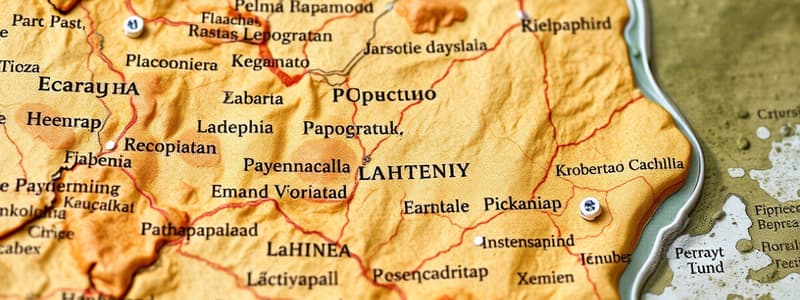Podcast
Questions and Answers
What does 'chernozem' refer to?
What does 'chernozem' refer to?
- A permanently frozen layer of soil
- Power generated by water
- Rich black soil (correct)
- Vast, treeless plains
What is hydroelectric power?
What is hydroelectric power?
Power generated by falling or rushing water
What is permafrost?
What is permafrost?
A permanently frozen layer of soil beneath the surface of the ground
Describe the tundra.
Describe the tundra.
What is the taiga?
What is the taiga?
What defines steppe climate?
What defines steppe climate?
What is an ethnic group?
What is an ethnic group?
What does nationality refer to?
What does nationality refer to?
What is a czar?
What is a czar?
Define serfs.
Define serfs.
What does Russification mean?
What does Russification mean?
Who were the Bolsheviks?
Who were the Bolsheviks?
What is communism?
What is communism?
Define satellite countries.
Define satellite countries.
What was the Cold War?
What was the Cold War?
What is perestroika?
What is perestroika?
What does glasnost refer to?
What does glasnost refer to?
What is atheism?
What is atheism?
Define patriarch.
Define patriarch.
What are icons in religious context?
What are icons in religious context?
What is a pogrom?
What is a pogrom?
What does intelligentsia refer to?
What does intelligentsia refer to?
Define socialist realism.
Define socialist realism.
What is a command economy?
What is a command economy?
What are consumer goods?
What are consumer goods?
What is the black market?
What is the black market?
Define market economy.
Define market economy.
What does privatization mean?
What does privatization mean?
What is radioactive material?
What is radioactive material?
What are pesticides?
What are pesticides?
Flashcards are hidden until you start studying
Study Notes
Agriculture and Geography
- Chernozem refers to rich black soil that is highly fertile, essential for agriculture.
- Hydroelectric power is energy produced from falling or rushing water, a key renewable resource in the region.
- Permafrost is a permanently frozen layer of soil, affecting land use and infrastructure in Russia.
- Tundra consists of vast, treeless plains found in high northern latitudes, characterized by a harsh climate.
- Taiga is a forest belt covering two-fifths of European Russia, extending into Siberia, known for coniferous trees.
Climate and Demographics
- Steppe climate is defined by temperate grasslands that experience long, cold winters with sparse snow.
- An ethnic group consists of people sharing common ancestry, language, and customs, crucial in Russia’s diverse cultural landscape.
- Nationality denotes a group's legal attachment and allegiance to a specific place or nation.
Historical Context and Governance
- A czar is the title for the supreme ruler in Russia, historically symbolizing autocratic power.
- Serfs were virtually enslaved workers bound to the land, under the control of noblemen, central to Russia's feudal system.
- Russification aimed to enforce Russian language and Eastern Orthodox Christianity on all ethnicities within the Russian Empire.
Revolutionary Movements
- Bolsheviks, led by Vladimir Lenin, seized control of Russia in 1917, initiating communist rule.
- Communism is a socio-political philosophy advocating for class equality, inspired by Karl Marx's theories.
Cold War Era and Policies
- Satellite countries were sovereign nations under the influence of the Soviet Union during the Cold War.
- The Cold War signify a prolonged conflict between communist and capitalist ideologies for global influence.
- Perestroika was a policy focusing on economic restructuring in the Soviet Union during Gorbachev’s leadership.
- Glasnost pursued increased political openness and transparency within the government under Gorbachev.
Religion and Culture
- Atheism is the belief in the absence of a God or supreme being, prevalent in Soviet ideology.
- A patriarch serves as a spiritual leader within the Eastern Orthodox Church, a significant aspect of Russian culture.
- Icons are religious images or symbols integral to Orthodox Christianity practice.
Social Issues and Artistic Expression
- A pogrom refers to organized massacres and persecution of Jews in Russia, reflecting historical anti-Semitism.
- Intelligentsia denotes the intellectual elite such as educators, writers, and artists contributing to cultural discourse.
- Socialist realism was an artistic approach mandated by the Soviet government, glorifying communist achievements in art.
Economic Systems
- A command economy is characterized by a central authority, usually the government, making significant economic decisions.
- Consumer goods are essential items necessary for daily life, reflecting the standard of living in society.
- The black market entails illegal trade of goods, often at inflated prices, circumventing government regulations.
- A market economy signifies a system where businesses are privately owned, with production determined by supply and demand dynamics.
- Privatization involves transferring ownership from the government to private entities, reshaping the economic landscape.
Environmental Concerns
- Radioactive material is associated with contamination from nuclear energy production, raising health and safety issues.
- Pesticides are chemicals utilized to eliminate agricultural pests, posing challenges regarding health and environmental impact.
Studying That Suits You
Use AI to generate personalized quizzes and flashcards to suit your learning preferences.




